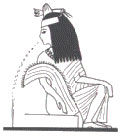|
Women
in Ancient Egypt
Prescription
for safeguarding a woman whose vagina is sore during movement:
You shall ask her "What do you smell?" If she
tells you "I smell roasting," then you shall
know that it is nemsu symptoms from her vagina. You should
act for her by fumigating her with whatever she smells
as roasting.

Kahun
Medical Papyrus
|
Women
suffered from deadly diseases such as smallpox, leprosy,
spina bifida, polio. Even smaller problems, such as diarrhoea
and cuts, could prove fatal! Almost everyone suffered
from rheumatism and abscessed teeth (the desert sands
got into most Egyptian foods). Doctors or scribes, other
than giving advice for such conditions, occasionally even
got into giving advice for such things as 'female troubles'
and tips for the complexion!
In
ancient fiction, women tended to be secondary figures
to the plot. She was the wife, daughter or mother, left
behind while the man went off on his adventure. This points
towards the fact that tales were written by men, for men.
It is not until the end of the Dynastic period where women
started actually characteristised in stories - mostly
as bad women. For example, in the Tale of the Two Brothers,
as in the story of Joseph in Egypt, the woman was married
(in this case, to one of the brothers), yet she made advances
to the hero of the story. He rejected her and in revenge
told her husband that the hero had raped her. In this
story, even the hero (who avoids this trap) married, and
was betrayed by an unfaithful wife!
Love
songs and romantic poems had a much more favourable image
of women. Semi-erotic, they showed women who expressed
their own sexuality, showing that women desired men just
as much as men desired women. References to sexual intercourse
were freely written, showing Egypt's relaxed attitude
towards sexual relationships.
|

|
Women, Food and Drink
| When
it comes to food and drink, women could eat and drink
as much as their male counterparts. Although Egyptians
tend not to be depicted actually eating food, they were
shown drinking. |
|
The
Egyptian word for 'to pour' sti also meant 'to impregnate'
(depending on the added determinative hieroglyph), so these
scenes could well be visual puns! Women were even depicted
as getting drunk and throwing up, which was seen as a good
Egyptian joke!
Women's
Education and Career
Other
than the scribe god Thoth's wife Seshat - the goddess of writing
- very few women were seen with a scribe's writing kit, let
alone actually seen writing! These high ranking or royal women
were often given a private tutor, who taught them reading
and writing. The female pharaoh Hatshepsut's daughter, Neferura,
had a private tutor, Senmut (one of Hatshepsut's favourite
courtiers). Surprisingly, some ostraca suggest that some ordinary
housewives were able to read and write - there were laundry
lists, female fashion advice and other female concerns found!
These women, though, would be the wives of educated men, so
this was not common through the land of Egypt.
Despite
this, due to the fundamental biology of a women, she only
had a certain range of jobs available to her. She was married
at the age when the males were starting their job training,
and naturally became mother and housewife, though a wife could
become her husband's official representative from time to
time. For example, if a husband was absent, she could take
charge of his business for him. When a high-class woman found
little to occupy her time, a religious position such as a
priestess for a certain god or goddess, was encouraged. In
this capacity, she was expected to make contributions to the
temple - and was not just a "pretty face" for the
particular temple she worked for.
Women
with talent could get jobs in the music scene (which has links
to sexuality), weaving or mourning (the women hired to grieve
at funerals), while those well connected women could get professional
positions such as domestic supervisors or domestic administrators.
Women who took people into their servicegenerally employed
women, while men took men into their service.
|
|